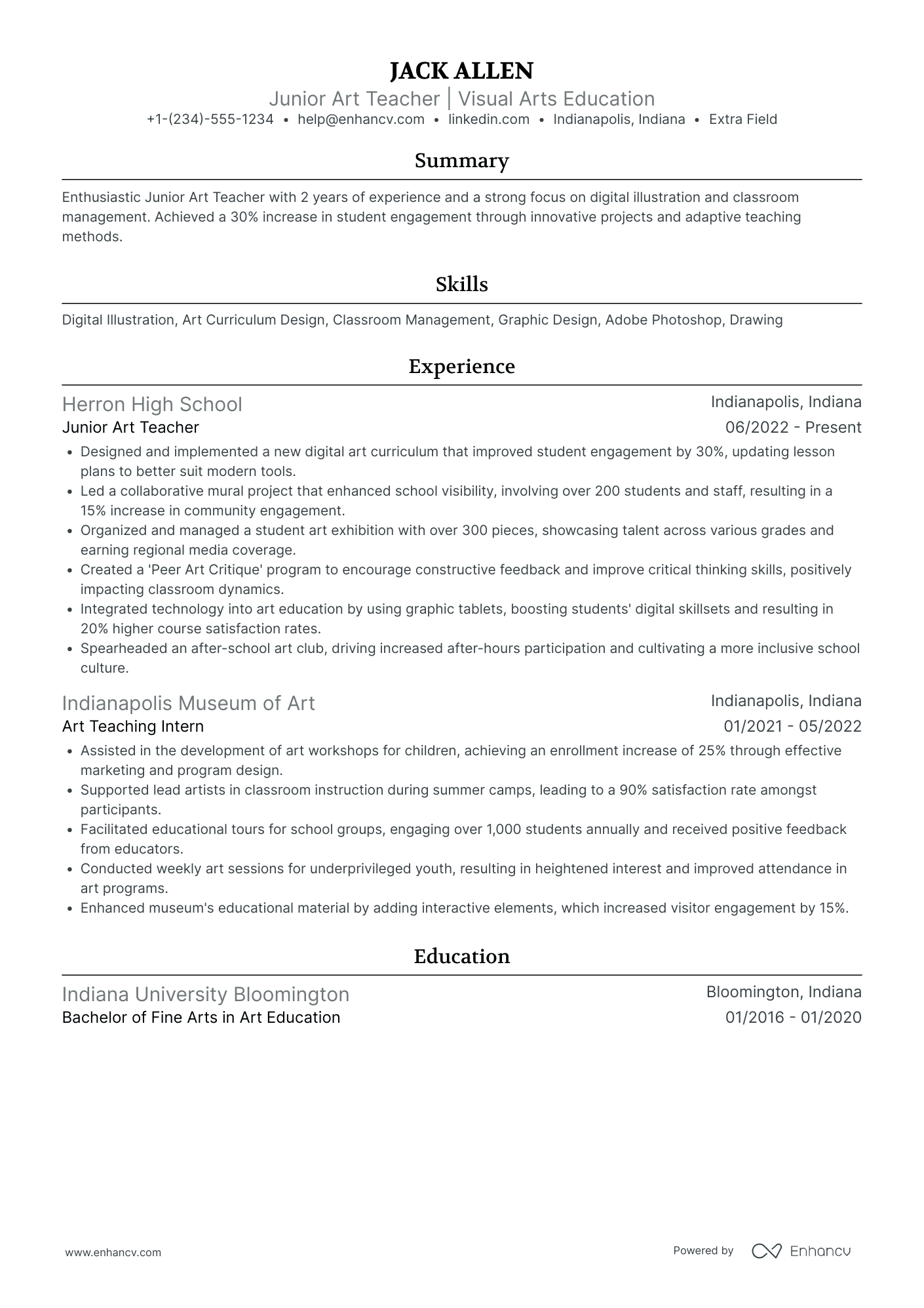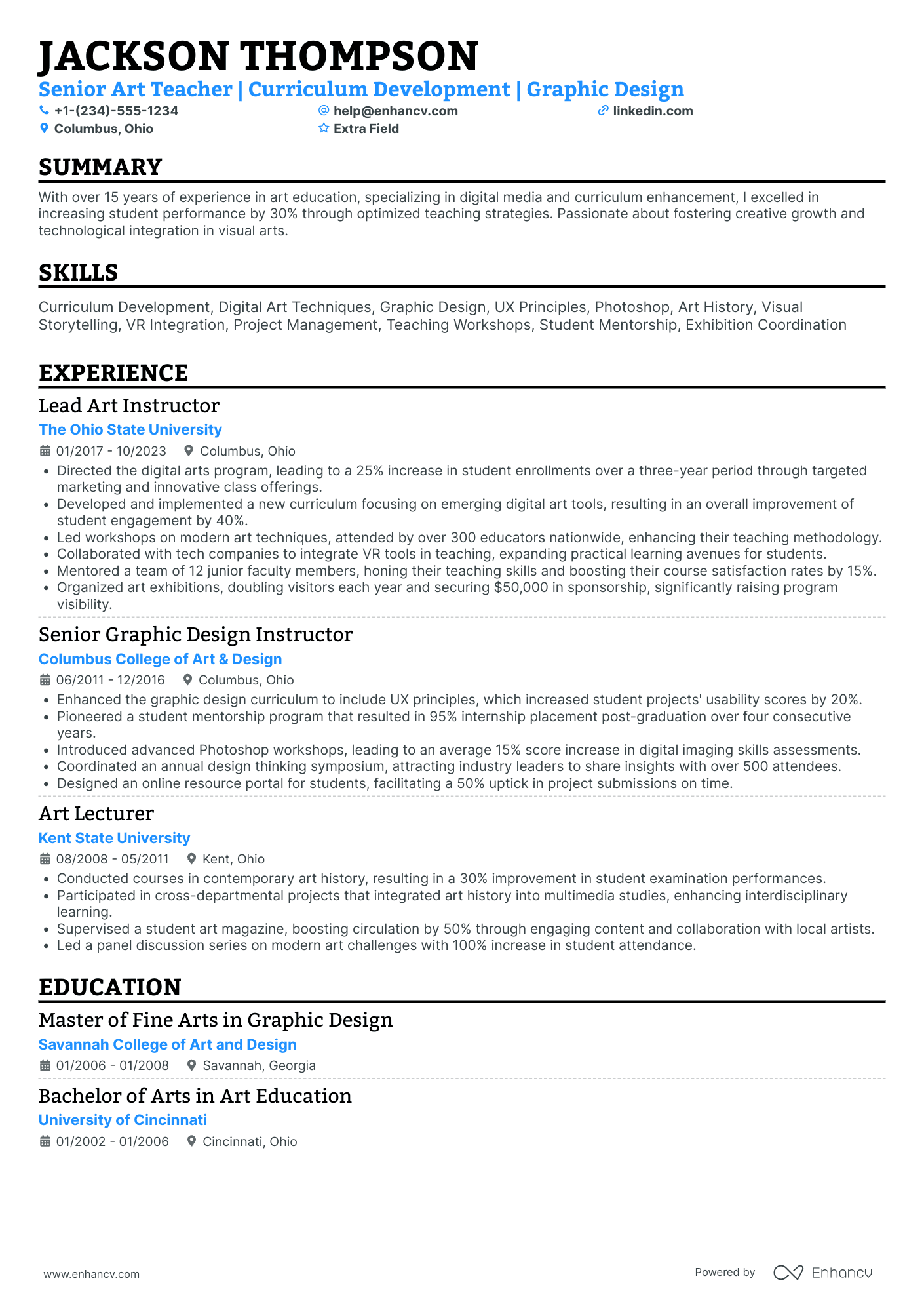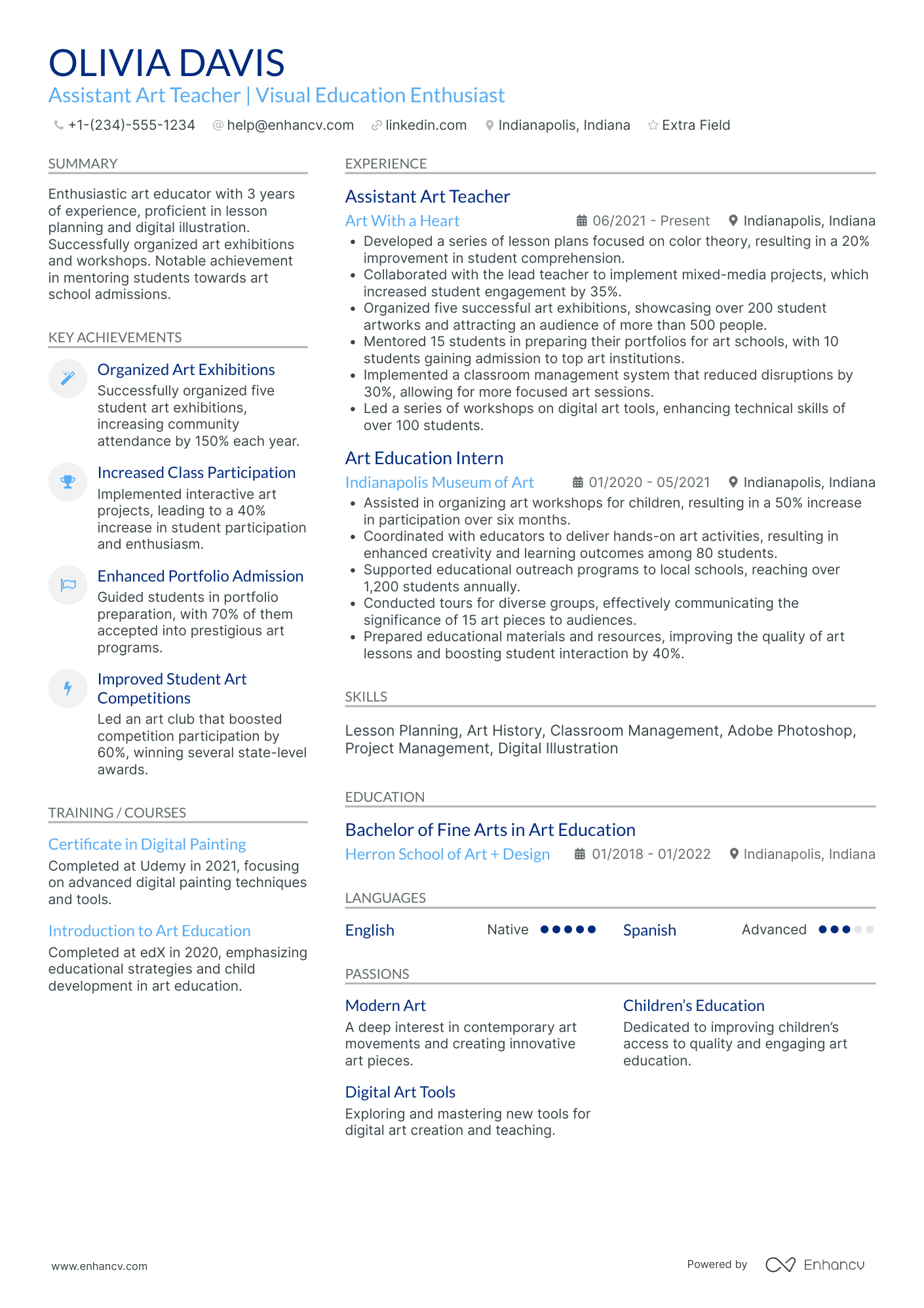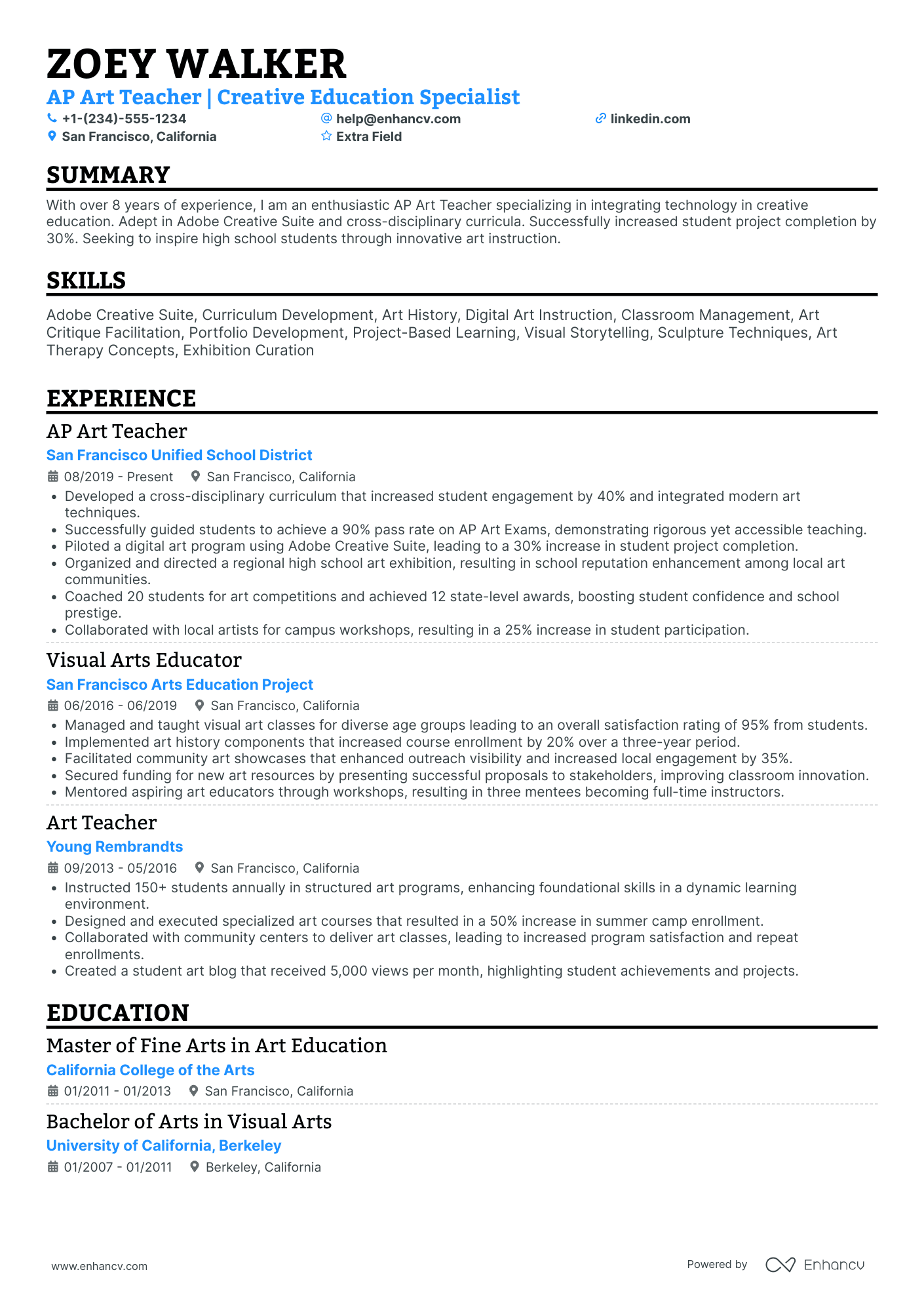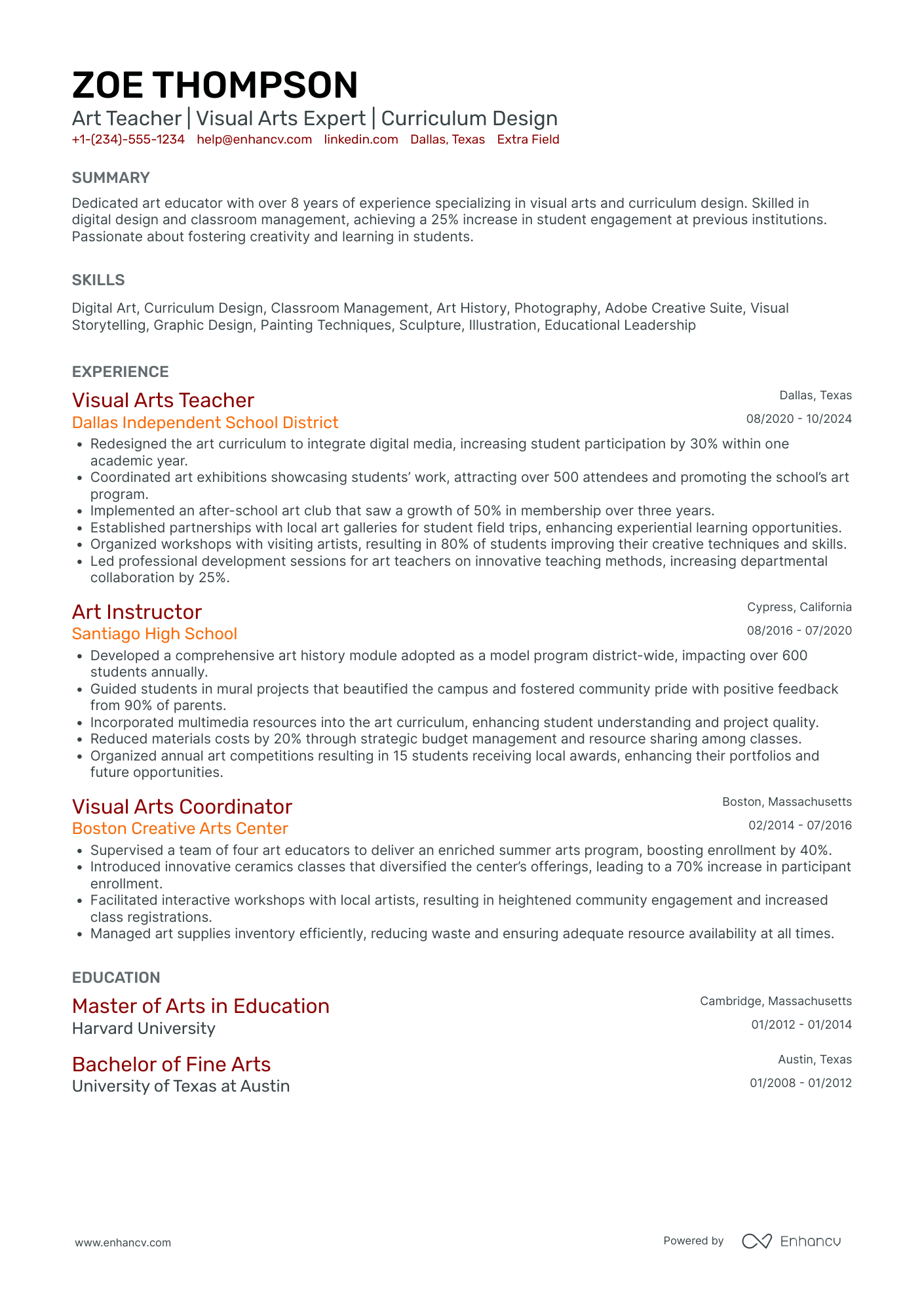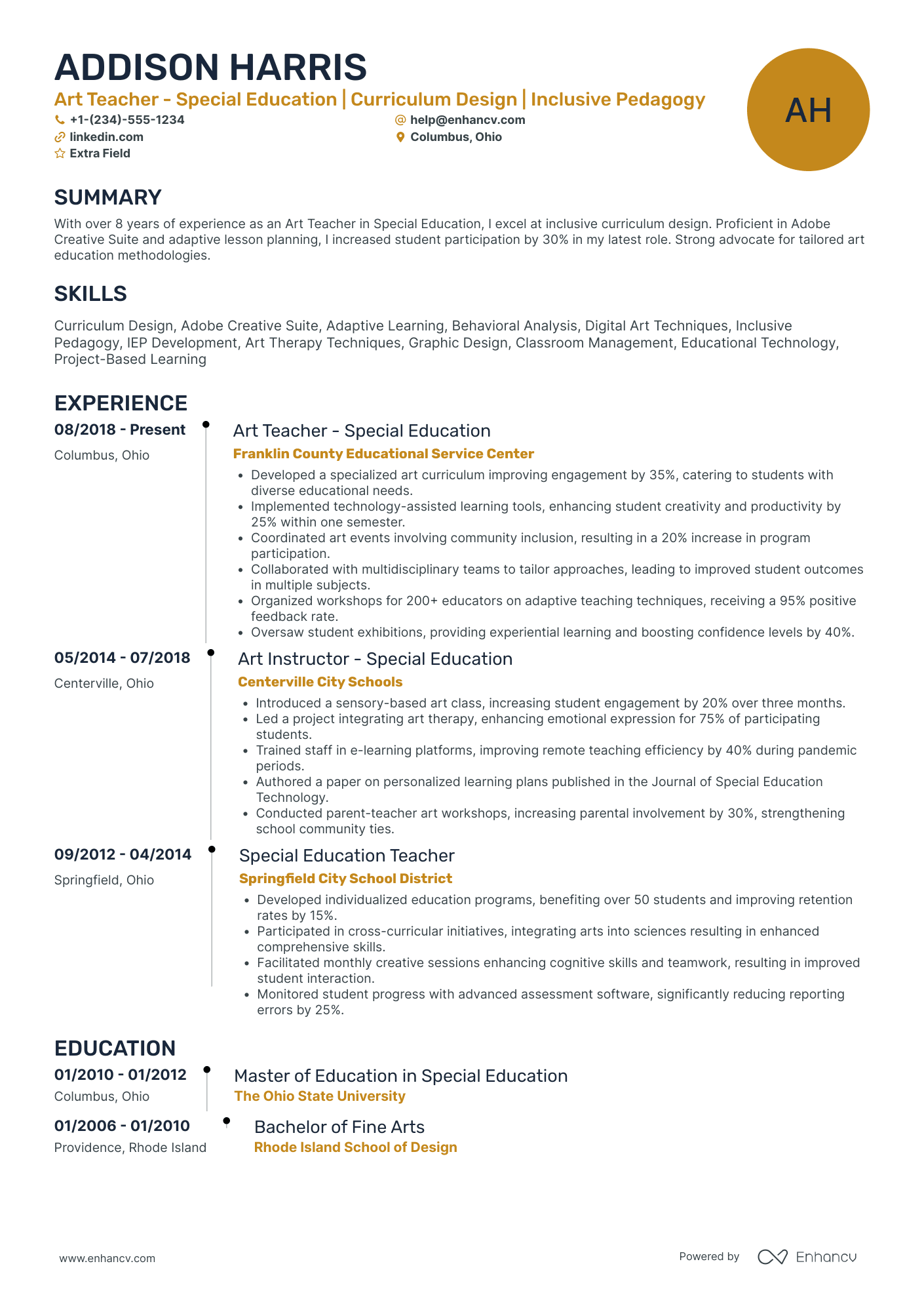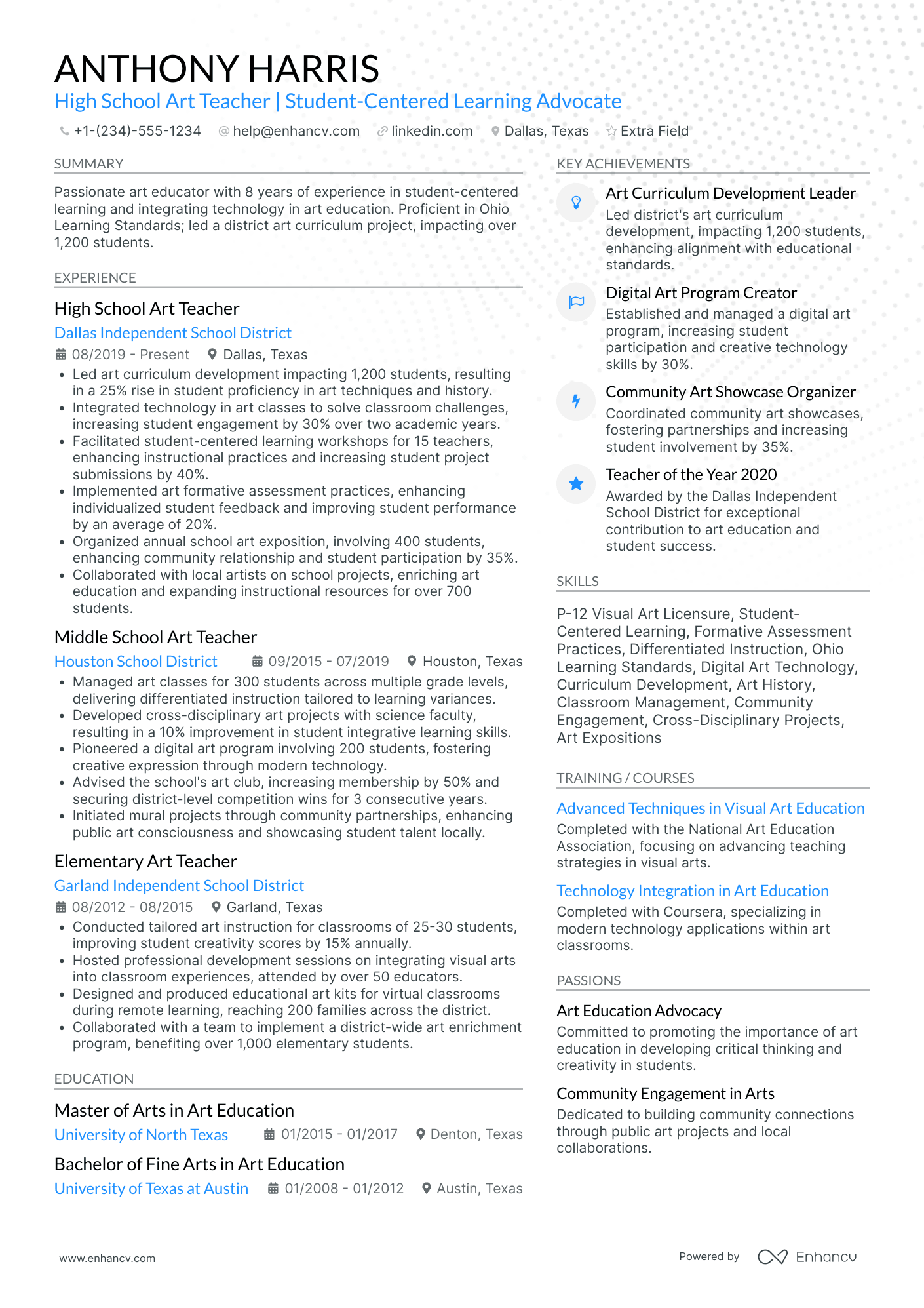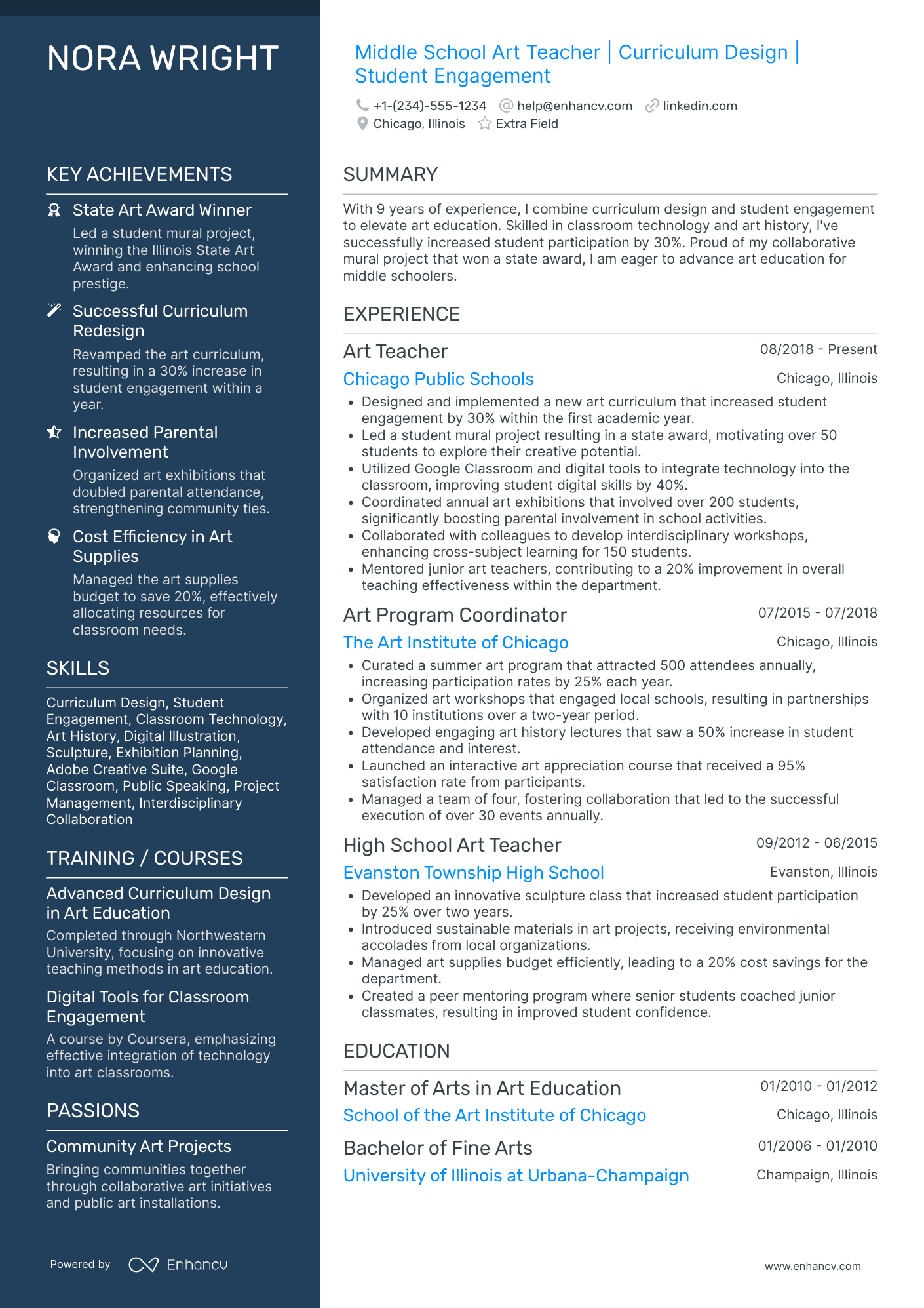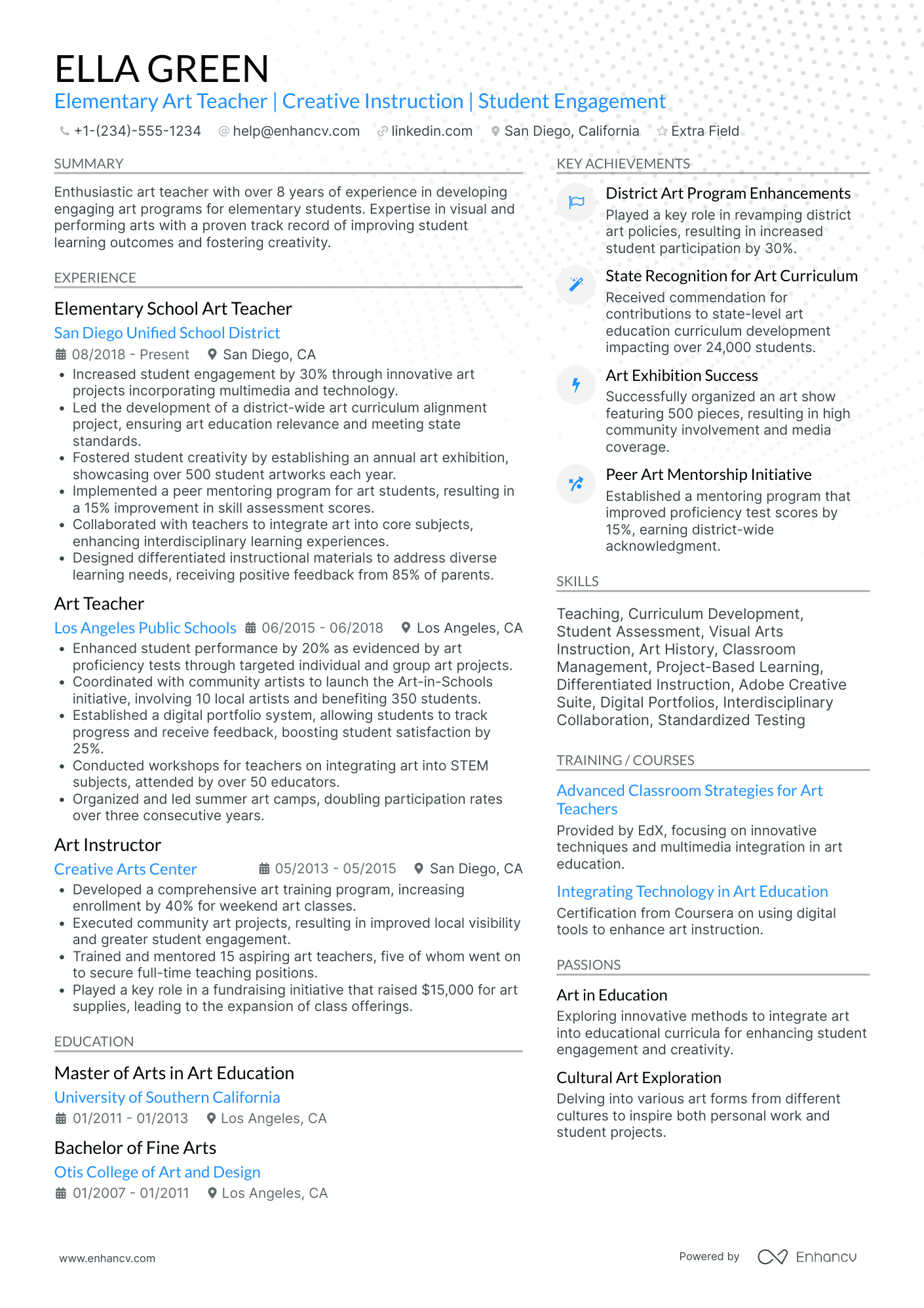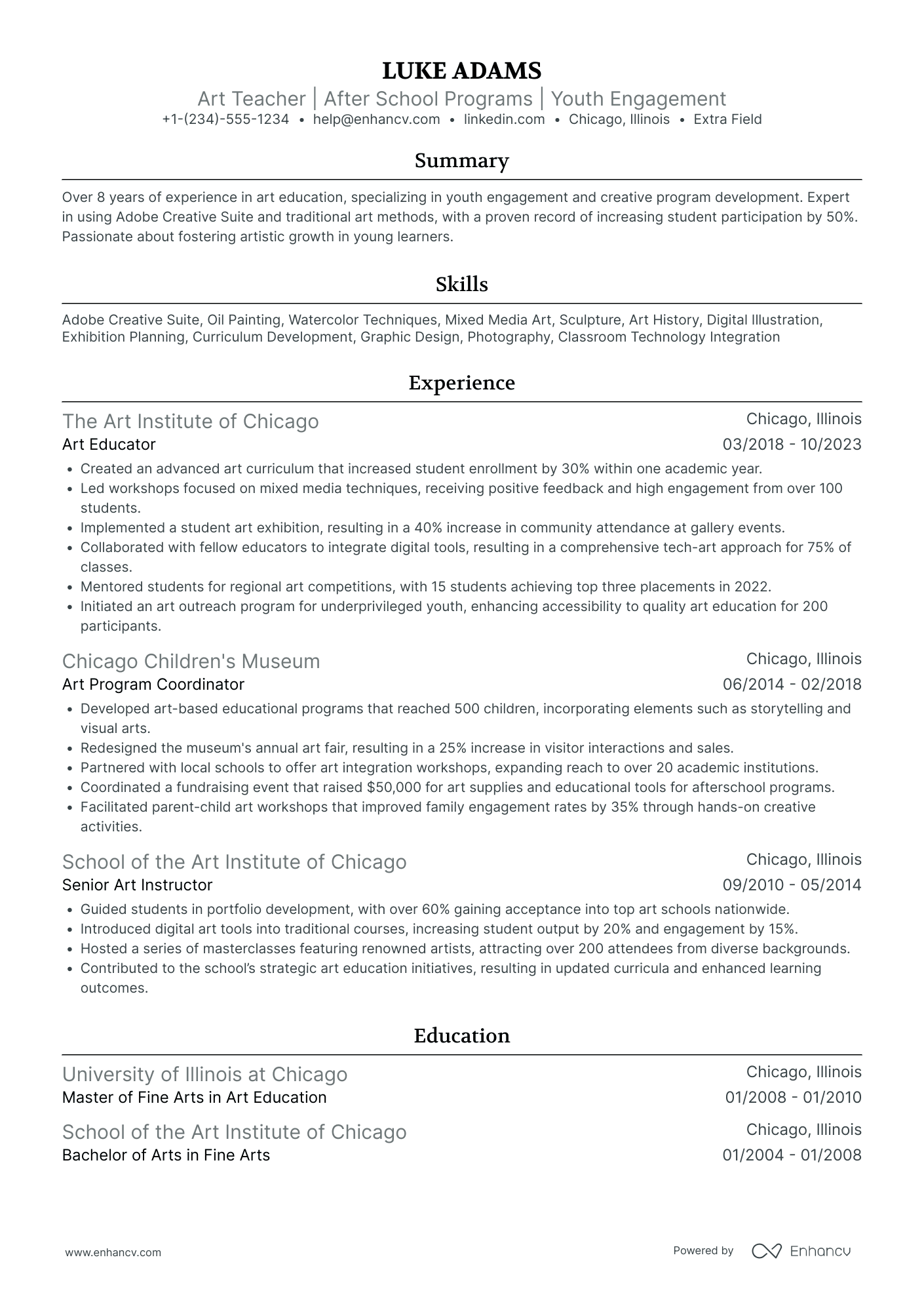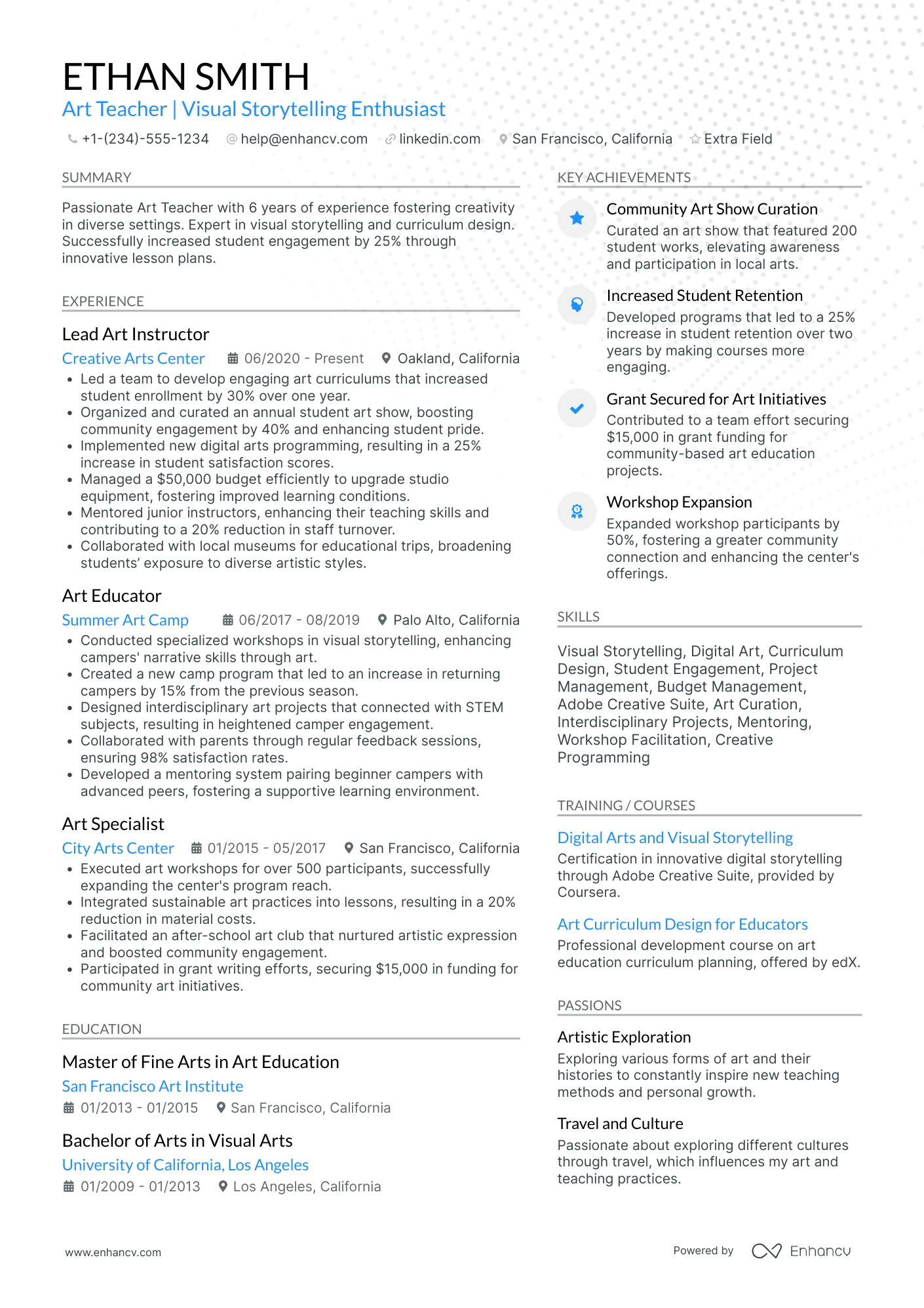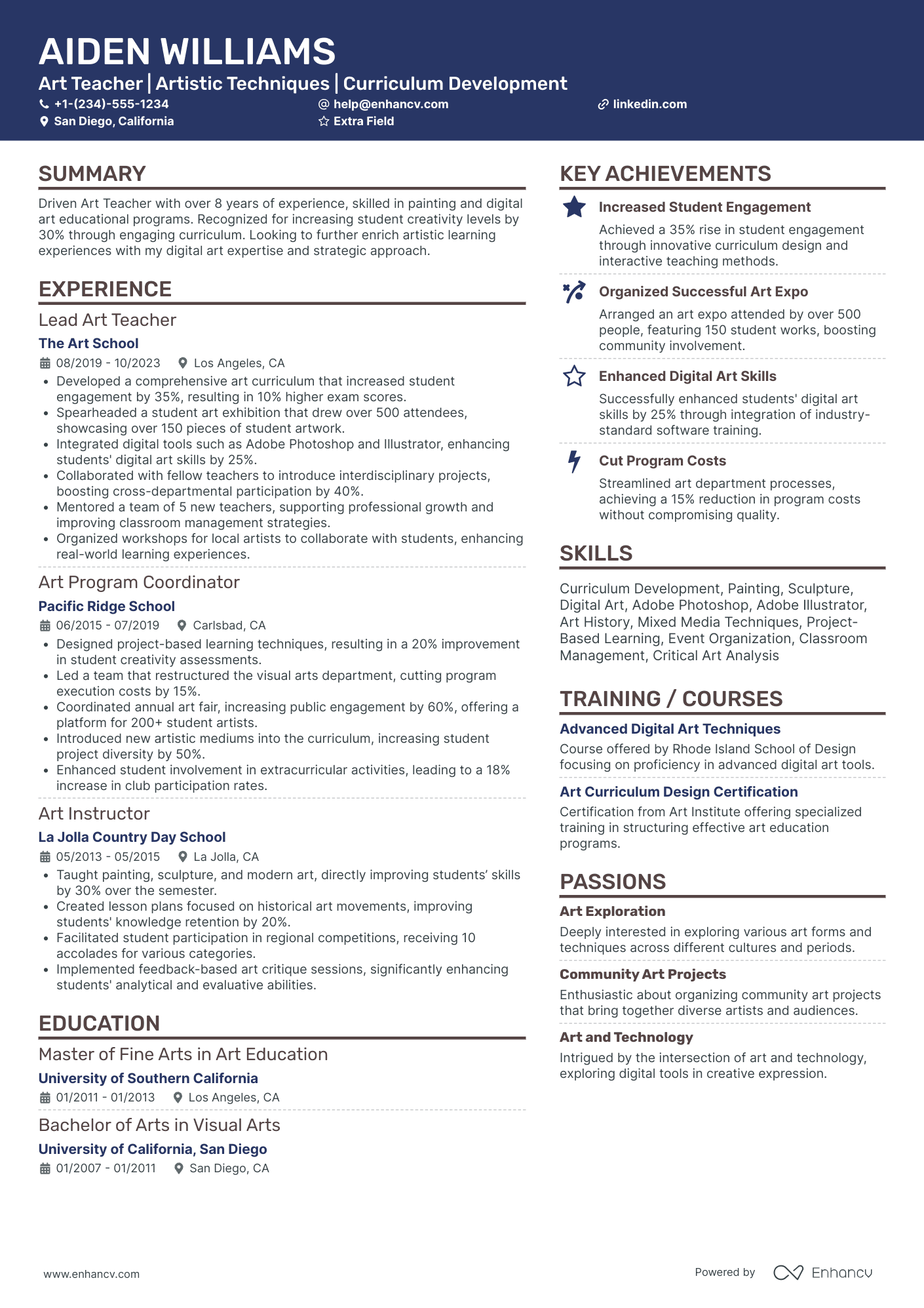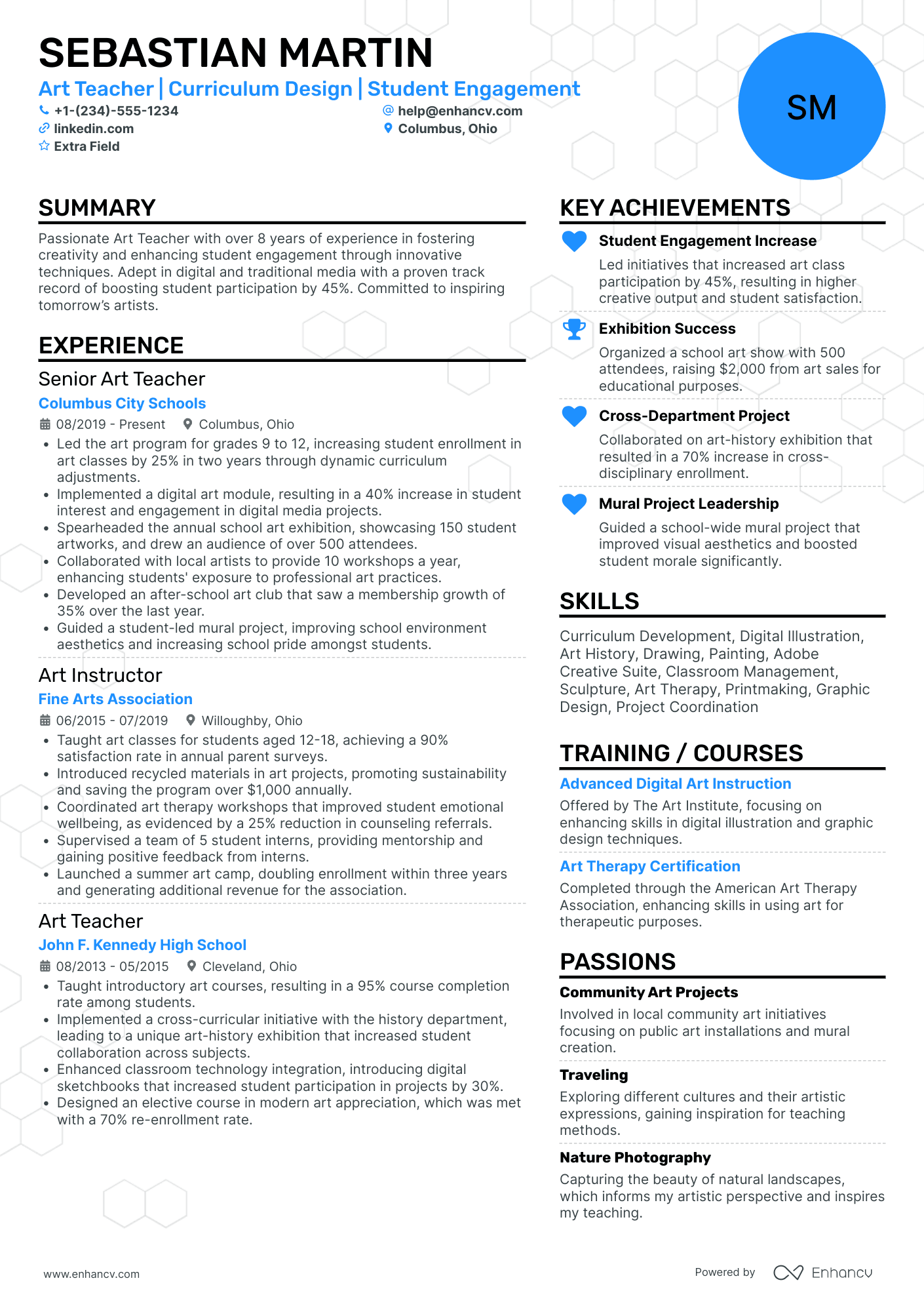Writing a resume as an art teacher can feel a bit like channeling your inner Bob Ross. You start with a blank canvas, armed only with your palette of experiences and achievements. But instead of happy little trees, you're painting a picture of your professional journey, hoping to capture the eye of school administrators.
It’s about mixing the right blend of skills, experiences, and that dash of personal flair that make all the difference. So grab your brushes (or keyboards) and let’s get into resume crafting, ensuring each stroke highlights your unique contributions to art education.
This guide will cover:
- The ideal resume format and templates to highlight your artistic talents effectively.
- How to describe your experience in arts and crafts and showcase your expertise.
- Key educational and licensing details that differentiate you from other candidates.
- The latest skill requirements for art teachers and how they can be listed on a resume.
- Critical elements to consider when crafting a teacher’s resume.
- How to write a compelling resume summary that captures your way with students and your work approach.
Before you turn the white canvas into a great resume, you might want to consider some other education-related guides:
- Dance Teacher Resume
- Elementary Teacher Resume
- Music Teacher Resume
- English Teacher Resume
- Math Teacher Resume
- Middle School Teacher Resume
- Lead Teacher Resume
- Transitioning Teacher Resume
- Social Studies Teacher Resume
- History Teacher Resume
- After-School Teacher Resume
- Virtual Teacher Resume
- Teacher Resume
- Artist Resume
- Art teacher Cover Letter
The best art teacher resume format
When crafting a resume, art teachers can choose from three main formats, depending on your career needs and highlights. Each of these formats offers a unique way to present your artistic and teaching credentials, helping you paint the perfect picture of your professional life to potential employers.
Here’s a guide to selecting the right format for your artistic and teaching journey:
- Reverse-chronological resume: It’s the most traditional resume format and lists your work history in reverse chronological order, starting with your most recent position at the top. It’s best suited for art teachers with a solid and progressive teaching career. If you’ve consistently grown in your field, moving from one teaching position to another with increasing responsibility or specialization, this format showcases your development and depth of experience in the education sector.
- Functional resume: Also called the skill-based format, it focuses on your skills and experiences rather than your chronological work history. It’s best for those who are changing careers, have gaps in their employment, or are new to the teaching world. For example, you may be an artist transitioning into teaching or have taken significant breaks for other artistic pursuits. Then, use a functional resume to emphasize your artistic skills and teaching capabilities without focusing on the timeline.
- Combination (hybrid) resume: As the name suggests, this format combines elements of both chronological and functional resumes. It starts with a detailed listing of skills and qualifications followed by a chronological professional history. If you’ve worked in various educational settings, led workshops, and also had formal teaching roles, the combination resume lets you showcase a balanced view of your diverse capabilities.
Resume designs
- Template: If you want your resume to highlight your artistic skills alongside your teaching experience, go for a double-column template. It allows you to present your creative projects or art exhibition history in one column and your teaching experience and education in the other, creating a visually engaging layout.
- Margins: Keep your resume margins between 0.5 and 1 inch. This ensures that the document is clean and uncluttered, which implies an ability to organize information—a key skill for any educator.
- Colors: Choose subtle colors that reflect your artistic style without overwhelming the professional tone of the resume. Soft pastels or earth tones can be a good choice for art teachers, offering a touch of creativity while keeping the look sophisticated.
- Fonts: Select clear, ATS-friendly fonts, sized between 10 and 12 points. Serif fonts like Times New Roman and Volkhov are very common in your field. You can use a different secondary font for headings to add a personal artistic touch, just make sure it’s not too fancy as it may not pass ATS filters.
- Length: Aim for a one-page resume, unless you have extensive professional art and teaching experiences that require more space. Prioritize relevant information that directly supports your candidacy for the teaching position.
Resume header
- Contact information: Start with your name, job title, and location. Ensure your contact information is professional, including an email address.
- Links: Include a link to your professional portfolio or personal website displaying your artwork or teaching materials. This is crucial for art teachers to showcase their practical skills and artistic expression.
- Resume photo: Generally, it’s best to omit photos to maintain focus on your qualifications and avoid potential biases. However, for a people-facing position like this, check the specific requirements.
File format and naming
- Creative touches: To ensure ATS compatibility, maintain a simple resume format. You can still infuse your resume with creativity. For instance, the graphic elements available in Enhancv’s resume builder are designed to be ATS-friendly, allowing you to enhance your resume’s visual appeal without risking getting rejected by automated filters.
- File format: Always save your resume as a PDF to preserve the layout and formatting across different devices.
- Naming convention: Name your file professionally; for example, ‘FirstNameLastNameArtTeacher_Resume.pdf’.
Consider your target market – resumes in Canada, for example, follow different layout conventions.
If you already have a resume, run it through our AI-powered resume checker to see how it scores against a real ATS.
Is your resume good enough?
Drop your resume here or choose a file. PDF & DOCX only. Max 2MB file size.
Now, consider the resume sections we’ll pay special attention to in this guide.
The top sections on an art and craft teacher resume
- Education and certifications showcasing your formal training and qualifications.
- Teaching experience detailing your history and skills in educating students.
- Artistic achievements highlight your personal and professional art accomplishments.
- Skills section demonstrating both your artistic techniques and teaching abilities.
- Workshops and seminars section showing your ongoing professional development.
Before we explore each one individually, here’s what school administrators will be looking for in your resume:
What recruiters want to see on your resume
- Demonstrated teaching experience: Recruiters prioritize this to ensure candidates have practical experience managing classrooms and instructing students effectively.
- Artistic skills and media proficiency: Important to show capability in various art forms and techniques that can be taught to students.
- Curriculum development: Recruiters look for experience in planning and implementing educational content, which is key to fostering a dynamic learning environment.
- Exhibition history: Indicates active participation in the art community and provides proof of personal engagement and professional recognition in the field.
- Student engagement and outcomes: Evidence of ability to inspire and improve student skills and creativity is highly valued as it reflects directly on teaching effectiveness.
Now, let’s focus on the most substantial part of your art teacher resume—your work history section.
How to write your art teacher resume experience
Remember that for the arts and crafts teacher role, hiring managers are looking to see how your expertise aligns with their requirements. Here are a few expert tips on how to create a targeted experience section.
- Include only roles that are relevant to the teacher job you're applying for.
- Don't go too far back in your experience. 10 years should be enough to complete a one-page resume.
- For each entry list your position, workplace, location, and 3-5 bullet points.
- Each bullet you include should say what you did, followed by the skills you used and the actual result of your efforts.
- Quantify each of your achievements with numbers and possibly the overall effect they had on the organization;
- Highlight personal skills you've gained thanks to past jobs. This would showcase your unique value as a professional.
To illustrate how we tailor a resume to a specific job description, let’s explore two examples—one good, and one not so much.
Below is the job posting they were tailored to.
Job purpose: Create and implement a flexible program and classroom environment favorable to student learning and personal growth. Develops lesson plans consistent with established guidelines. Establish effective rapport with students, staff members, and parents. Motivate students to develop skills, attitudes and knowledge to provide an effective educational foundation, in accordance with each student’s ability.
Instruction/Education Responsibilities
- Plans and implements a program of instruction that adheres to the company's philosophy, goals and objectives as outlined in the adopted courses of study.
- Makes purposeful and appropriate lesson plans which provide for effective teaching strategies and maximizes time on task.
- Presents subject matter to students to maximize learning opportunity and provides real-world, application based examples and learning opportunities.
- Reviews student records in order to develop a foundation of understanding regarding each student's abilities and needs. Maintain accurate and complete student records.
- Strives to maximize the educational achievement of each student.
- Utilizes a variety/range of student learning modalities in each lesson and uses differentiated instruction within those lessons.
- Utilizes diagnostic assessment of student learning on a frequent basis.
- Maintains accurate and completes student records.
- Assesses student strengths and weaknesses on a frequent basis, provides appropriate activities to address student needs and generates progress reports as required.
Skills and knowledge
- Possesses strong time management & organizational skills and the ability to prioritize effectively.
- Has the ability to establish and maintain effective working relationships with teachers, students, parents, the community, and administrative staff. Is sensitive to sensitive to corporate needs, employee goodwill, and the public image, as unique situations present themselves.
- Possesses excellent interpersonal skills and displays such between all stakeholders: being courteous, professional, and helpful.
- Possesses excellent communication skills: Oral (including presentations), Written, Interpersonal (active listening), Negotiating and Influencing.
- Has the ability to be at work consistently, to be on time, to follow instructions, to respond to management direction and to solicit feedback to improve performance.
- Demonstrates proficient experience with Microsoft Office (Word, Excel, PowerPoint), Student Information System (SIS) and email communications.
Here’s a far-from-impressive art teacher’s experience section.
- •Handled various lesson plans each year, using different types of art.
- •Set up a few student art shows annually.
- •Kept records for students and adjusted teaching methods as needed.
- •Used different teaching strategies to help students learn better.
- •Conducted some workshops on using technology in teaching art.
This is problematic. The points are vague and lack details like specific numbers and achievements, which dilutes the impact of the teacher's accomplishments. We don’t see critical details about the teacher’s skills and initiatives, making it difficult for potential employers to understand the candidate’s skill set and specialization areas.
Now, let’s try again and create a version that better matches the job description above.
- •Designed and executed over 200+ lesson plans annually, incorporating techniques such as digital art, sculpture, and traditional painting to enhance student artistic literacy.
- •Organized and curated 5+ annual student art exhibitions, showcasing student works and increasing exposure to community arts.
- •Maintained detailed achievement and progression records for 150+ students, utilizing assessments to tailor artistic instruction and support individual creative development.
- •Implemented art-specific differentiated instruction strategies, improving student engagement and artistic skills development across varied learning abilities.
- •Led professional development workshops for 20+ fellow art educators on integrating technology in art education, enhancing the department's instructional methods.
Here’s what this entry does best:
- Use of action verbs: Starting each bullet with a strong action verb such as "Designed," "Organized," "Maintained," "Implemented," and "Led" clearly illustrates the candidate's active role and leadership in various responsibilities.
- Quantified achievements: By specifying numbers (e.g., "200+ lesson plans annually," "5+ annual student art exhibitions," "150+ students"), the bullets provide concrete evidence of the scope and scale of the teacher's responsibilities and achievements. Quantifying these details helps to communicate the extent of the teacher's capabilities and impact.
- Highlighting specific skills and knowledge: The bullets focus on specialized skills such as digital art, sculpture, and traditional painting techniques, as well as abilities in curating exhibitions and integrating technology in education.
- Demonstration of personal skills: The resume highlights personal skills like leadership in professional development and adaptability in teaching methods. These qualities are essential for any educator, especially in art, where teaching often requires nurturing creativity and responding to diverse student needs and learning styles.
- Relevance to art education: Each bullet point is tailored to underscore experiences and skills that are particularly relevant to an art teaching position. This targeted approach ensures the resume resonates well with hiring managers looking for candidates who can contribute effectively to their art programs.
How to quantify impact on your resume
You might think numbers don’t matter on an art-related resume. Well, consider how you would evaluate a piece of art: you need to see it firsthand. Similarly, resumes need to have concrete evidence of your accomplishments. Adding numbers makes your achievements stand out as more persuasive and credible.
Quantified results provide a clear, objective basis for hiring managers to compare the effectiveness of different candidates. It’s about making your successes easy to see and appreciate at a glance.
Here are a few suggestions on how an art teacher can quantify their impact on a resume:
- Include the percentage increase in student participation in art shows under your guidance, demonstrating your ability to engage and motivate students.
- Mention the specific number of art techniques you are proficient in, like 10+ techniques including digital art and ceramics, highlighting your diverse skill set.
- State the exact number of educational grants you have secured for art supplies and projects, reflecting your initiative and ability to enhance resources.
- Detail the number of student art pieces sold or displayed in professional settings, showing your effectiveness in promoting student talent to real-world audiences.
- Quantify the improvement in student grades or artistic skill assessments over your tenure, evidencing your impact on student development.
- List the number of professional development workshops you have led or created, underscoring your leadership and commitment to educational advancement.
- Report the percentage of former students who have pursued higher education in arts, indicating your inspirational influence on students' career paths.
- Specify the number of collaborations with local artists or galleries you've facilitated, showcasing your community connections and real-world application of art education.
These simple tips can help you craft a strong, persuasive resume, even if you’re just starting out. If that’s the case, the next part of this guide is just for you.
I have come to believe that a great teacher is a great artist and that there are as few as there are any other great artists. Teaching might even be the greatest of the arts since the medium is the human mind and spirit.
John Steinbeck
How do I write an art teacher resume with no direct experience
There are currently nearly 70,000 art teacher job openings across the US, with a job growth rate of 4%. Additionally, the teacher shortage in certain areas creates more opportunities for junior professionals. This suggests there's room for everyone, including those new to the field.
However, you'll still need a standout resume. Here's how you can downplay limited experience and highlight your potential:
- Highlight your education: Start with your educational background, especially if you have a degree in art or art education. Include any coursework related to teaching or child development to demonstrate your foundational knowledge.
- Emphasize relevant experience: Even without direct classroom experience, you likely have other relevant experience. Have you led workshops, organized art events, or volunteered with children? These are great to list as they show leadership and teaching potential.
- Detail any internships or volunteer work: Activities that involved art or working with students can be positioned as practical teaching experience.
- Showcase your artistic skills: Create a section dedicated to your artistic skills and media you specialize in. If possible, include a link to an online portfolio. Providing visual evidence of your artwork can strengthen your candidacy.
- Emphasize soft skills: Highlight traits like creativity, patience, communication, and the ability to motivate and inspire others. Provide examples where you have successfully used these skills in any setting, which can help paint a picture of how you’ll perform in a classroom.
- List professional development: Any courses in teaching strategies, classroom management, or related areas can be advantageous. These show your commitment to becoming an educator.
- Quantify achievements: Where possible, use numbers to quantify your achievements. For example, “Led a workshop for 20+ participants on watercolor techniques,” which provides a tangible measure of your teaching capabilities.
- Write an objective statement: This type of professional statement is best suited for individuals who have less than three years of experience and focuses on your career goals and motivations.
- Use a functional resume format: Opt for a functional resume format that emphasizes your skills and qualifications rather than a chronological list of experiences. This helps to draw attention to your strengths and potential as an art teacher.
PRO TIP
Remember, your resume is your chance to make a strong first impression. Tailor it for each job application to highlight the aspects of your background that are most relevant to the specific art teacher position you are applying for.
See? Even without direct teaching experience, your passion for art and education can shine through with the right details and presentation.
Next, let’s dive into the skills an art teacher should showcase on their resume to be considered for a job interview.
Art teacher resume skills and how to list them
When it comes to art teaching and the modern-day skill requirements, the outlook can be summarized as follows:
In the field of education, skills that will become even more important and prevalent are really at, what I would consider, opposite ends of a spectrum: at one end, interpersonal skills—strength and knowledge in the areas of social and emotional learning and trauma-informed teaching; at the other end, technology skills—refining and enhancing information literacy and digital literacy skills.
Dr. Audrey Church Ph.D
Balancing these opposites is not impossible. Moreover, showcasing your diverse skill set on your resume can provide a competitive advantage over other candidates.
Start by establishing a dedicated section for your hard skills. This will not only help ATS systems identify relevant keywords more easily but also allow school administrators to assess your competencies.
Best hard skills for your art teacher resume
- Drawing
- Painting
- Sculpture
- Ceramics
- Digital art
- Graphic design
- Photography
- Printmaking
- Adobe Creative Suite
- 3D modeling software
- Video editing
- Art history knowledge
- Curriculum development
- Classroom management tools
- Lesson planning
- Assessment techniques
- Educational technology
- Kiln operation
- Safety procedures in art
- Mixed media artistry
- Trauma-informed teaching
- Social-emotional learning (SEL) practice
Staying updated with relevant software and modern teaching techniques is crucial, but being a dependable role model for students is equally important.
Describing your interpersonal skills on a resume is a bit less straightforward. Unlike technical skills, which can be validated through certifications from training courses, soft skills need context to be described.
Have a look at the detailed list of the most wanted soft skills for teachers.
Best soft skills for your art teacher resume
- Patience
- Empathy
- Emotional intelligence
- Problem-solving
- Time management
- Organization
- Leadership
- Team collaboration
- Critical thinking
- Flexibility
- Motivation
- Enthusiasm
- Conflict resolution
- Cultural sensitivity
- Stress management
- Active listening
- Persuasion
- Innovation
Here's the thing. Instead of dedicating a separate section to soft skills, weave evidence of these qualities throughout your resume. Here’s how you can do it:
- Identify keywords from the job description.
- Reflect on which of these skills you genuinely possess.
- Integrate these skills into various sections of your resume, such as the experience or summary sections.
- Provide specific examples that demonstrate your mastery of each skill.
For example:
‘Developed and implemented an inclusive art curriculum tailored to diverse learning needs, resulting in a 30% increase in class participation and engagement among students with special needs.’
An experience entry like this illustrates the teacher’s sensitivity and adaptability to the needs of students with learning disabilities, without explicitly mentioning the skills in question.
In the next section of this guide, we explore the right way to list your educational background on your resume.
How to list your education and certifications on your resume
The educational requirements for art teachers in the U.S. can vary depending on the state and the level of education (elementary, middle, high school, or postsecondary). However, there are some common requirements across most states:
- Bachelor’s degree: art teachers generally need at least a bachelor’s degree in Art Education, Fine Arts, or a related field. This degree should provide a comprehensive education in various art forms and may also include coursework in pedagogy and child development.
- Art and core competency: Many states require art teachers to pass the National Evaluation Series (NES), Praxis, and other teacher preparation programs.
- State certification/Licensure: Public school art teachers must be certified or licensed by the state in which they teach. To maintain licensure, art teachers may need to continue their education through professional development courses or workshops
- Background check: As with most positions that involve working with children, art teachers must pass a criminal background check.
Since these elements are all critical for your role and credibility, they should be clearly displayed on your resume. Below is a good example of an education section you can re-create on your document:
- •Honors: Graduated Magna Cum Laude
- •Relevant Coursework: Advanced Sculpture Techniques, Educational Psychology, Digital Media in Art Education, Methods of Teaching Art
This education section clearly highlights a strong academic record at a prestigious institution which is well-regarded in the field of art education. Including the GPA and graduation honors (Magna Cum Laude) underscores the aspiring teacher’s dedication and excellence in academic performance. What’s more, the detailed listing of relevant coursework such as "Advanced Sculpture Techniques" and "Digital Media in Art Education" directly aligns with the skills necessary for an art teacher.
However, that alone doesn’t qualify you for an art teacher position. You need your state certification prominently displayed, along with some other important credentials that showcase your eligibility for the job. For instance:
Top certifications for your art teacher resume
Here’s how your certifications section should look:
Note that after listing the certificate and issuer, you should also mention the year you obtained the certification, as many require renewal after a certain period of time. Some organizations might ask for your transcripts, too.
As for your state licensure, it’s best to put it in the resume header as shown in this elementary art teacher resume:
How to write your art teacher resume summary
As a teacher, your skills as a wordsmith will make crafting your professional profile a breeze. Use our guidelines below to create a compelling resume summary.
- Review the job description and pinpoint the most important skills and qualifications that align with your experience.
- Integrate these keywords into your summary, ensuring it is concise with no more than five sentences.
- Avoid using the first-person perspective.
- Start each sentence with strong adjectives or dynamic verbs.
- Conclude by expressing your enthusiasm to contribute to the school community.
Now, here’s an art teacher’s summary that fails to impress.
This summary is unconvincing. It uses vague language such as "many years in education" and "different art forms and techniques," which don’t clearly convey any expertise or impact.
See how this generic career statement can be transformed into something way more compelling.
This drawing teacher resume summary is specific and impactful. It clearly highlights the candidate’s solid background. By stating their expertise in digital art and sculpture, the teacher demonstrates a skill set that's highly relevant for the role. They also mention a specific number that provides concrete evidence of effectiveness. Finally, ending with their "passion for inspiring creativity and critical thinking in students" adds a personal touch, indicating that they’re genuinely dedicated to the students' growth and the broader school environment.
Resume objectives are slightly different, as we mentioned earlier. They’re more suitable for entry-level positions and focus on your career goals and potential impact. Below is an example you can adapt for your own resume:
Optimize your resume summary and objective for ATS
Drop your resume here or choose a file.
PDF & DOCX only. Max 2MB file size.
Additional sections for an art teacher resume
Before we wrap up, let's go over some other resume sections that you may want to consider. They could provide a more comprehensive view of your qualifications and accomplishments as an art teacher.
- Student achievements: Showcase notable achievements of students under your guidance, such as awards, recognitions, scholarships, or successful college admissions in art programs. This can be a great testament to your success.
- Community involvement: Detail involvement in community art projects, volunteer work, or collaborations with local art organizations. Highlight contributions to school and community art programs or events.
- Grants and funding: Mention any successful grant applications or funding secured for art programs, projects, or classroom resources.
- Professional affiliations: List memberships in professional organizations such as the National Art Education Association (NAEA) or other relevant art and education associations.
- Workshops and classes taught: Highlight any additional workshops or classes taught outside of regular school settings, such as summer camps, after-school programs, or adult education courses.
- Language skills: A languages section on an art teacher's resume can be highly beneficial, especially if you're applying to schools with diverse student populations or in multilingual regions.
How to put a seminars section on your resume
One of the most important additional sections for your teacher resume is “Seminars”. Attending these often indicates that you have acquired specialized knowledge and skills that are relevant to your role. This can set you apart from other candidates by highlighting your expertise in specific areas.
Here’s how to list them:
- Put the title of the seminar, followed by the date it took place.
- Write a short description of the topic discussed.
When creating your resume on Enhancv's resume builder, you can use the "Courses" section and rename it to "Seminars" to better fit your needs.
Key takeaways
Creating a resume can sometimes feel like an art project—after all, you're showcasing your best self! Let's dive into the essential tips that will make your resume a masterpiece.
- Choose a resume layout that meets your career needs and highlights.
- Design a clear, readable, and keyword-rich resume to pass ATS filters and impress recruiters.
- Quantify your impact by giving concrete examples of how you made a difference in your previous roles.
- Aim for a good balance between your artistic skills and your educational experience.
- Make sure your licenses and certifications are up to date and placed prominently on your resume.
- Create a strong summary that captures all your unique qualities.
Art Teacher resume examples
By Experience
By Role
